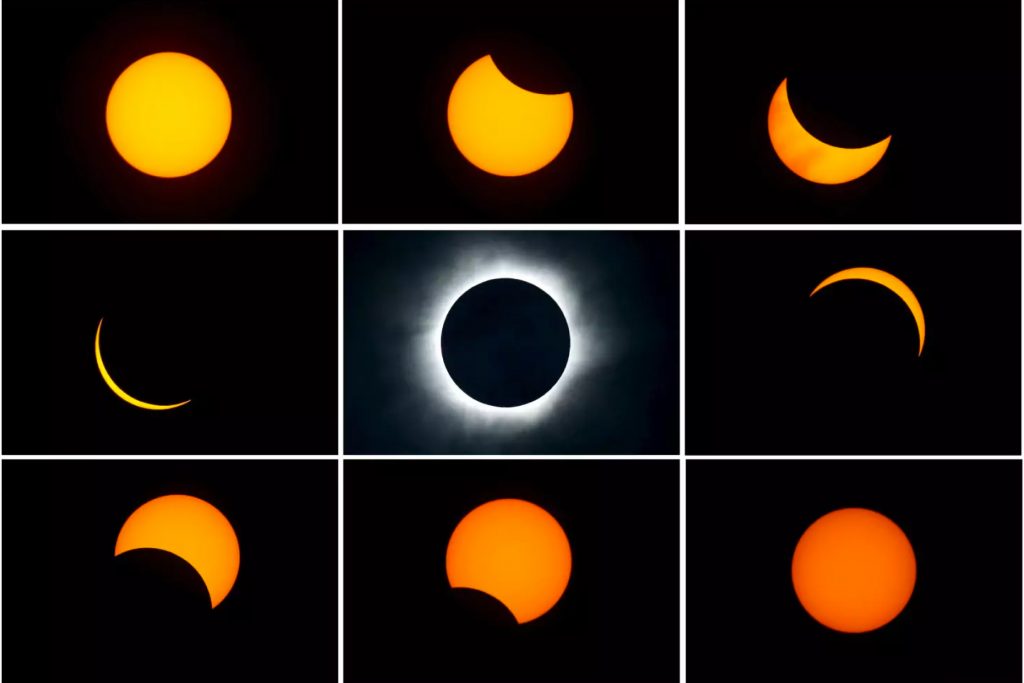
by Sam Candler
We were so happily enthralled and overshadowed by the solar eclipse of August 21, 2017! What awe! What mystery! What fun! Some of us had made plans for months to travel to some spot within the seventy mile “path of totality.” Others of us took off work to watch with special glasses or homemade pinhole viewers. Those who experienced the total eclipse, when the world became dark for up to two minutes or so, were spectacularly moved. Others of us shared their thrill vicariously.
Wherever we were, it was wonderful for us to pause, and to let it be. Recognizing, and imagining, the paths of two huge celestial bodies—heavenly bodies!—crossing each other was a truly awe-inspiring event. I would say that those several hours on August 21, of waiting and watching, touched people with transcendence, a sense of majesty and power that was so much bigger than us. Moreover, we shared those transcendent moments with other people: some of them friends, but others in campgrounds and parks, and some of them strangers we happened to park beside along the road. We shared both transcendence and intimacy.
For some of us, the more we studied the event, the more profound particular details became. We were aware that the moon’s shadow was racing across the continent at between 1000 and 3000 miles per hour. We were aware of slight angles in the earth’s and moon’s orbits that make an eclipse possible. We were aware that the precise size of the moon, at this particular time in its gradual withdrawal from the earth, is what makes a total eclipse possible—and not an annular eclipse (which does not completely cover the disc of sun).
Finally, some of us became aware of something else. Solar eclipses are not exactly rare. They are certainly rare if you stay in one place on the earth. However, they occur somewhere on earth about once every eighteen months—about two every three years. Indeed, many people claim to be “eclipse chasers,” making plans even now to be at the next solar eclipse on July 2, 2019 (though most of it will occur over water, in the South Pacific Ocean). I read where Joseph Pasachoff, astronomer from Williams College, has experienced 65 solar eclipses.
I reckon, then, that if we include space and time outside earth, then celestial bodies—let’s call them heavenly bodies!—are intersecting their paths somewhere, almost all the time. Stars are crossing in front of other stars. Moons are coming between suns and planets. (These events are called “occultations,” which means “hidings.”)
In the tremendous universe of God, then, there is always an intersection happening somewhere. What if we, we ourselves, are also such heavenly bodies? Sometimes, we are depending upon one light source, and another body moves between us and the source. Sometimes that movement occurs with amazing speed. We can see the shadow moving quickly along the floor, and it overtakes us. Sometimes the shadow is not a negative phenomenon at all, and the darkness can be helpful to us. Darkness can also show us that we have other sources of energy to depend upon, other sources of growth. In short, the darkness can both excite and calm us, showing us again our particular place in the tremendous order and creation of God.
Yes, we human beings are heavenly bodies, too. We make paths and trails and orbits and intersections. When we meet another heavenly body—let’s call that heavenly body a spirit, shall we?—when we meet another spirit, when our paths cross, we have the opportunity for a fruitful intersection, we have the opportunity to say hello, to wink, to pause and to rejoice. (Or we have the opportunity to resent the shadow, to resent the interruption.)
The glory of this week’s total solar eclipse, then, can teach us about our own eclipses and intersections, and overshadowings. It is restorative simply to pause, and to marvel, at the glorious constellation of heavenly bodies among whom we live, and move, and have our being. We salute the complicated wonder of this universe of heavenly bodies. All of us travel in beautiful orbits. When our paths cross, a fruitful intersection will be that same combination of transcendence and intimacy that so many of us experienced August 21, 2017.
It is worth remembering one of the most mysterious and transcendent of all intersections: the one between divine and human. That intersection will always be impossible to fully describe, but here is how the gospel writer, Luke, described it: “The Holy Spirit will come upon you, and the power of the Most High will overshadow you” (Luke 1:35). Right. It’s a miracle. And it can happen in us. And it can happen all the time.
Sam Candler is Dean of the Cathedral of St. Philip in Atlanta, Georgia. His articles can also be followed at his blog, Good Faith and the Common Good.

